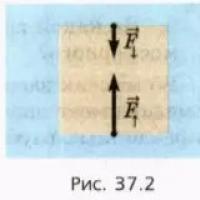The occurrence of earthquakes. Earth disasters - earthquakes
In times of high technology and established rhythms of life, people often forget that they do not control everything until the end. And the manifestations of global events such as earthquakes are only in a few cases truly noticeable. But if this cataclysm does reach civilized corners, this event may remain a scar on people's memories for a long time.
How does an earthquake happen?
Vibrations of the earth's surface, as well as tremors, are the process of an earthquake. Scientists believe that the earth's crust consists of 20 huge plates. They move at a very low speed of about a few centimeters per year through the upper layer of the mantle. The boundaries between plates are often mountains or deep-sea trenches. Where the slabs slide over each other, the edges become folded. And in the crust itself, cracks form - tectonic faults, through which mantle material seeps to the surface. Natural disasters such as earthquakes and volcanic eruptions often occur in these places. The area of shock wave divergence sometimes extends for hundreds of kilometers.
Causes of the earthquake
- Collapses of large masses of rock due to impact groundwater often cause earth tremors at a short distance.
- In areas of active volcanoes, under the pressure of lava and gases top part crust, nearby areas are exposed to weak but prolonged tremors, often on the eve of an eruption.
- Man-made activities of people - the construction of dams, mining activity, nuclear weapons testing, accompanied by powerful underground explosions or redistribution of internal water masses.


How an earthquake occurs - earthquake foci
But not only the cause itself directly affects the power of the earthquake, but also the depth of the source of occurrence. The source or hypocenter itself can be located at any depth, from several kilometers to hundreds of kilometers. And it is a sharp displacement of large massifs of rocks. Even with a slight shift, vibrations of the earth's surface will occur, and the range of their movement will depend only on their strength and sharpness. But the further the surface, the less destructive the consequences of the cataclysm will be. The point above the source in the ground layer will be the epicenter. And is often subject to the greatest deformation and destruction during movement seismic waves. 

How an earthquake occurs - zones of seismic activity
Due to the fact that our planet has not yet stopped its geological formation, there are 2 zones - the Mediterranean and the Pacific. The Mediterranean stretches from the Sunda Islands to the Isthmus of Panama. The Pacific covers Japan, Kamchatka, Alaska, moves further to the California mountains, Peru, Antarctica and many other places. There is constant seismic activity due to the formation of young mountains and volcanic activity.


How does an earthquake occur - the strength of the earthquake
The consequences of such earthly activity can be dangerous. There is a whole science for studying and recording it - seismology. It uses several types of measurements of magnitude - a measure of the energy of seismic waves. The most popular Richter scale with a 10-point system.
- Less than 3 points are recorded only by seismographs due to their weakness.
- From 3 to 4 points a person already feels slight swaying of the surface. The environment begins to react - the movement of dishes, the swaying of chandeliers.
- At 5 points, the effect is enhanced; in old buildings, interior decoration may crumble.
- 6 points can significantly damage old buildings, causing rattling or cracking of glass in new houses, but they are already damaged at 7 points;
- Points 8 and 9 cause significant destruction over large areas and bridge collapses.
- The strongest magnitude 10 earthquakes are also the rarest and cause catastrophic destruction.


- When living in high-rise buildings, you should understand that the lower a person is, the better, but during evacuation you cannot use elevators.
- It is worth leaving buildings and moving away from them to a safe distance (turning off electricity and gas), avoiding large trees and power lines.
- If it is not possible to leave the premises, you need to move away from window openings and tall furniture or hide under a strong table or bed.
- While driving, it is better to stop and avoid high points or bridges.


Humanity cannot yet prevent earthquakes, or even predict in detail the reaction of the earth's crust to seismic shocks. Due to the huge number of variables involved, these are incredibly complex forecasts. A person successfully passively defends himself in the form of strengthening buildings and improving the layout of infrastructure. This allows countries located on the line of constant seismic activity to develop successfully.
A series of tremors in 30 seconds practically destroyed the city of Spitak and caused severe destruction to the cities of Leninakan (now Gyumri), Kirovakan (now Vanadzor) and Stepanavan. In total, 21 cities were affected by the disaster, as well as 350 villages (of which 58 were completely destroyed).
In the epicenter of the earthquake - the city of Spitak - its strength reached 10 points (on a 12-point scale), in Leninakan - 9 points, Kirovakan - 8 points.
The 6-magnitude earthquake zone covered a significant part of the territory of the republic; tremors were felt in Yerevan and Tbilisi.
The catastrophic consequences of the Spitak earthquake were due to a number of reasons: underestimation of the seismic danger of the region, imperfection of regulatory documents on earthquake-resistant construction, insufficient preparedness of rescue services, slowness of medical care, and low quality of construction.
The commission to eliminate the consequences of the tragedy was headed by the Chairman of the Council of Ministers of the USSR Nikolai Ryzhkov.
In the first hours after the disaster, units of the USSR Armed Forces, as well as the Border Troops of the KGB of the USSR, came to the aid of the victims. On the same day, a team of 98 highly qualified doctors and military field surgeons, led by USSR Minister of Health Yevgeny Chazov, flew from Moscow to Armenia on the same day.
On December 10, 1988, after interrupting his official visit to the United States, Mikhail Gorbachev, General Secretary of the CPSU Central Committee, Chairman of the Presidium of the Supreme Soviet of the USSR, flew to Leninakan with his wife. He got acquainted with the progress of the ongoing rescue and restoration work on the spot. At a meeting with the heads of Union ministries and departments, priority tasks for providing the necessary assistance to Armenia were discussed.
In just a few days, 50 thousand tents and 200 field kitchens were deployed in the republic.
In total, in addition to volunteers, over 20 thousand soldiers and officers took part in the rescue work, and more than three thousand units of military equipment were used to clear the rubble. The collection of humanitarian aid was actively carried out throughout the country.
The tragedy of Armenia shocked the whole world. Doctors and rescuers from France, Switzerland, Great Britain, Germany, and the USA arrived in the affected republic. Planes carrying medicines, donated blood, medical equipment, clothing and food from Italy, Japan, China and other countries landed at the airports of Yerevan and Leninakan. Humanitarian assistance was provided by 111 states from all continents.
All material, financial and labor capabilities of the USSR were mobilized for restoration work. 45 thousand builders from all Union republics arrived. After the collapse of the USSR, the restoration program was suspended.
The tragic events gave impetus to the creation in Armenia and other republics of the USSR of a qualified and extensive system for preventing and eliminating the consequences of various emergency situations. In 1989 it was formed State Commission The USSR Council of Ministers for Emergency Situations, and after 1991 - the Russian Ministry of Emergency Situations.
In memory of the Spitak earthquake on December 7, 1989, the USSR issued a commemorative coin of 3 rubles, dedicated to the people's assistance to Armenia in connection with the earthquake.
On December 7, 2008, a monument dedicated to the tragic events of 1988 was unveiled in the center of Gyumri. Cast using collected public funds, it is called “For Innocent Victims, Merciful Hearts.”
The material was prepared based on information from RIA Novosti and open sources
Incredible facts
1. The largest earthquake reached magnitude 9.5 in Chile in 1960. It caused a giant tsunami that extended over 10,000 km.
8. Everest's height decreased by 2.5 cm after the 2015 earthquake that occurred in Nepal.
9. In 132 AD Chinese inventor created seismograph, which at the time of the earthquake threw a copper ball into the mouth of the dragon and the mouth of the frog.

10. About 500,000 detectable earthquakes occur each year. About 100,000 of them can be felt and 100 of them cause some kind of damage.
11. Average earthquake lasts about 1 minute.
12. Tremors can occur after a few years after the main earthquake.
Earthquake map
13. About 80 percent of major earthquakes on Earth occur near the "Ring of Fire"- A horseshoe-shaped area in the Pacific Ocean where many tectonic plates occur.
The second most powerful earthquake area is called " Mediterranean fold belt", which includes countries such as Türkiye, India and Pakistan.

14. An earthquake in 1201 in the eastern Mediterranean became deadliest in history, which killed more than 1 million people.
15. Scientists believe that animals can feel weak tremors before an earthquake. Perhaps animals sense electrical signals arising from underground shifts.
2004 Indian Ocean earthquake
16. The 2004 Indian Ocean earthquake lasted almost 10 minutes - this longest earthquake.

17. An earthquake can release energy hundreds of times greater than the energy released when the nuclear bomb fell in Hiroshima in 1945.
18. Before an earthquake, an unusual smell may appear in reservoirs and canals. This is caused by the release of underground gases. Temperatures groundwater may also increase.
19. An earthquake on the moon is called " moonquake"Moonquakes are usually weaker than earthquakes.
20. Earthquakes are usually caused by geological disturbances, but they can also be caused by landslides, nuclear weapons testing and volcanic activity.
Strongest earthquakes (since 1900)

1. Great Chilean earthquake, 1960
Epicenter - Valdivia, Chile
magnitude - 9.5
2. Great Alaska Earthquake, 1964
epicenter - Prince William Sound
magnitude – 9.2
3. Indian Ocean earthquake, 2004
Epicenter – Sumatra, Indonesia
magnitude – 9.1
4. Sendai earthquake, 2011
Epicenter – Sendai, Japan
magnitude – 9.0
5. Earthquake and tsunami in Severo-Kurilsk, 1952
Epicenter – Kamchatka, Russia
Magnitude - 8.5-9.0
The power of tremors is estimated by the amplitude of oscillations of the earth's crust from 1 to 10 points. Areas in mountainous areas are considered the most earthquake-prone. We present to you the most strong earthquakes in history.
The worst earthquakes in history
During the earthquake that occurred in Syria in 1202, more than a million people died. Despite the fact that the force of the tremors did not exceed 7.5 points, underground vibrations were felt along the entire length from the island of Sicily in the Tyrrhenian Sea to Armenia.The large number of victims is associated not so much with the strength of the tremors, but with their duration. Modern researchers can judge the consequences of the destruction of the earthquake in the 2nd century only from the surviving chronicles, according to which the cities of Catania, Messina and Ragusa in Sicily were practically destroyed, and the coastal cities of Akratiri and Paralimni in Cyprus were also covered by a strong wave.
Earthquake on the island of Haiti
The 2010 Haiti earthquake killed more than 220,000 people, injured 300,000, and left more than 800,000 missing. Material damage as a result of the natural disaster amounted to 5.6 billion euros. For a whole hour, tremors with a power of 5 and 7 points were observed. 
Despite the fact that the earthquake occurred in 2010, Haitians still need humanitarian assistance and are also rebuilding settlements on their own. This is the second most powerful earthquake in Haiti, the first occurred in 1751 - then the cities had to be rebuilt over the next 15 years.
Earthquake in China
About 830 thousand people died in the magnitude 8 earthquake in China in 1556. At the very epicenter of the tremors in the Weihe River valley, near Shaanxi province, 60% of the population died. The huge number of victims is due to the fact that people in the middle of the 16th century lived in limestone caves, which were easily destroyed even by minor tremors. 
Within 6 months after the main earthquake, so-called aftershocks were repeatedly felt - repeated seismic tremors with a power of 1-2 points. This disaster occurred during the reign of Emperor Jiajing, so in Chinese history it is called the Great Jiajing Earthquake.
The most powerful earthquakes in Russia
Almost a fifth of Russia's territory is located in seismically active areas. These include the Kuril Islands and Sakhalin, Kamchatka, the North Caucasus and the Black Sea coast, Baikal, Altai and Tyva, Yakutia and the Urals. Over the past 25 years, about 30 strong earthquakes with an amplitude of more than 7 points have been recorded in the country. 
Earthquake on Sakhalin
In 1995, an earthquake of magnitude 7.6 occurred on Sakhalin Island, as a result of which the cities of Okha and Neftegorsk, as well as several villages located nearby, were damaged. 
The most significant consequences were felt in Neftegorsk, which was 30 kilometers from the epicenter of the earthquake. Within 17 seconds, almost all houses were destroyed. The damage caused amounted to 2 trillion rubles, and the authorities decided not to restore the settlements, so this city is no longer indicated on the map of Russia.

More than 1,500 rescuers were involved in eliminating the consequences. 2,040 people died under the rubble. A chapel was built and a memorial was erected on the site of Neftegorsk.
Earthquake in Japan
The movement of the earth's crust is often observed in Japan, since it is located in the active zone of the volcanic ring of the Pacific Ocean. The most powerful earthquake in this country occurred in 2011, the amplitude of the vibrations was 9 points. According to a rough estimate of experts, the amount of damage after the destruction reached 309 billion dollars. More than 15 thousand people were killed, 6 thousand were injured and about 2,500 were missing. 
Tremors in the Pacific Ocean caused a powerful tsunami, the height of the waves was 10 meters. As a result of the collapse of a large flow of water on the coast of Japan, a radiation accident occurred at the Fukushima-1 nuclear power plant. Subsequently, for several months, residents of nearby areas were prohibited from drinking tap water due to its high cesium content.
In addition, the Japanese government ordered TEPCO, which owns the nuclear power plant, to compensate moral damages to 80 thousand residents forced to leave the contaminated areas.
The most powerful earthquake in the world
A powerful earthquake caused by the collision of two continental plates occurred in India on August 15, 1950. According to official data, the strength of the tremors reached 10 points. However, according to the conclusions of the researchers, the vibrations of the earth's crust were much stronger, and the instruments were unable to establish their exact magnitude. 
The strongest tremors were felt in the state of Assam, which was reduced to ruins as a result of the earthquake - more than two thousand houses were destroyed and more than six thousand people were killed. Total area The territories caught in the destruction zone amounted to 390 thousand square kilometers.
According to the site, earthquakes also often occur in volcanically active areas. We present to you an article about the highest volcanoes in the world.
Subscribe to our channel in Yandex.Zen
Earthquakes are underground tremors accompanied by vibrations of the earth's surface.
Causes and types
The location of earthquake foci practically coincides with the boundaries of lithospheric plates
Earthquakes are tectonic, volcanic and landslide.
Tectonic earthquakes arise due to sharp displacements of mountain plates or as a result of the displacement of an oceanic platform under the continent. After all, the surface of the earth consists of continental and oceanic platforms, which, in turn, consist of separate blocks. When blocks are placed on top of each other, they can rise up and mountains are formed, or they can fall down and depressions are formed, or one of the plates will go under the other. All these processes are accompanied by vibrations or shaking of the earth.
Volcanic earthquakes occur due to the fact that streams of hot lava and gases press from below on the surface of the Earth and thus make you feel that the earth is disappearing from under your feet. Volcanic earthquakes are usually not very strong, but can last quite a long time, sometimes several weeks. Often such earthquakes warn of an imminent volcanic eruption, which is even more dangerous than the earthquake itself.
Sometimes voids form underground, for example, under the influence of groundwater or underground rivers that erode the ground. In these places, the earth cannot withstand its own gravity and collapses, causing a slight shaking. It's called landslide earthquake.

After strong earthquakes, the landscape of the area changes, new lakes and mountains may appear
The most destructive and terrible are tectonic earthquakes. The place where plates collide or a powerful explosion occurs due to the release of energy accumulated in the earth is called earthquake source, or hypocenter. When the explosion occurs, a shock wave with a speed of more than 5 km/s (depending on the power of the explosion) begins to spread in all directions, reaches the surface of the earth (this area on the surface is called the epicenter, and it is located directly above the hypocenter) and diverges to the sides along circles. The epicenter is where the most destruction occurs, and on the outskirts of the area affected by the earthquake, people may not even feel anything.
Strength of earthquakes
Earthquakes are one of the most dangerous natural phenomena. They bring great destruction and disaster, destroying not only material assets, but also all living things, including people. The strength of an earthquake on the surface of the earth is measured in points on a special 12-point scale.

Point scale for measuring earthquake strength:
- 1 point - Not felt. Marked only with special devices
- 2 point - Very weak, noted only by domestic animals and some people in the upper floors of buildings
- 3 points - Weak. Only felt inside some buildings, like the shock when driving a truck
- 4 points - Moderate. You can hear the creaking of floorboards and beams, the clinking of dishes, and the shaking of furniture. Inside the building, the shaking is felt by most people
- 5 points - Quite strong. Tremors are felt in the rooms as if heavy objects were falling. Window glass breaks, chandeliers and furniture sway
- 6 point - Strong. Heavy furniture sways, dishes break, books fall from shelves, only very dilapidated houses are destroyed
- 7 point - Very strong. Old houses are being destroyed. In strong buildings, cracks appear and plaster crumbles. The water in rivers and lakes becomes cloudy
- 8 point - Destructive. Trees sway violently and strong fences break. Many strong buildings are being destroyed. Cracks appear in the soil
- 9 points - Devastating. Strong buildings are destroyed. Significant cracks appear in the soil
- 10 points - Destructive. Even strong buildings and bridges are destroyed. Landslides and collapses, cracks and bends in the soil occur
- 11th point - Disaster. Almost all stone buildings, roads, dams, and bridges are destroyed. Cracks with shifts form on the surface of the earth
- 12th point - Severe disaster. All structures are destroyed, the entire area is devastated. River courses are changing
Seismology

The seismograph pen draws a curved line in the form of sharp zigzags when tremors begin
Science studies earthquakes seismology. In different countries of the world, scientists conduct observations of the behavior of the earth's crust. They are helped in this by special instruments - seismographs. They measure and automatically record the slightest tremors occurring anywhere in the world. When the earth's surface oscillates, the main part of the seismograph - the suspended load - due to inertia, begins to move relative to the base of the device, and the recorder records the seismic signal transmitted to the marker.
An important task of seismology is earthquake prediction. Unfortunately, modern science cannot yet accurately predict them. Seismologists can more or less reliably determine the area and strength of an earthquake, but its onset is very difficult to predict.
Can an earthquake rock the Earth?
In mid-May 1960, one of the most significant and destructive earthquakes occurred in Chile - the Great Chilean Earthquake. Despite the fact that the main vibrations of the earth occurred in the southwestern part South America- the epicenter of the earthquake was located near the city of Valdivia - their “echoes” reached other territories of our planet: in particular, the Hawaiian Islands and Japan. The phenomenon in which an earthquake that occurs in one part of the earth causes other parts of the earth to pulsate and tremble, even those located thousands of kilometers from the epicenter, is called “swing” or “vibration” of the earth.
 What documents are evidence that the apartment is a service apartment?
What documents are evidence that the apartment is a service apartment? Space donut hole
Space donut hole Types of discounts on Russian Railways tickets and rules for obtaining them Train tickets for students
Types of discounts on Russian Railways tickets and rules for obtaining them Train tickets for students Lecture on syndromic pathology
Lecture on syndromic pathology Organizational aspects of the activities of pharmacy organizations
Organizational aspects of the activities of pharmacy organizations Water pressure in the depths of the ocean Practice reports
Water pressure in the depths of the ocean Practice reports What is inductance, its definition and unit of measurement
What is inductance, its definition and unit of measurement